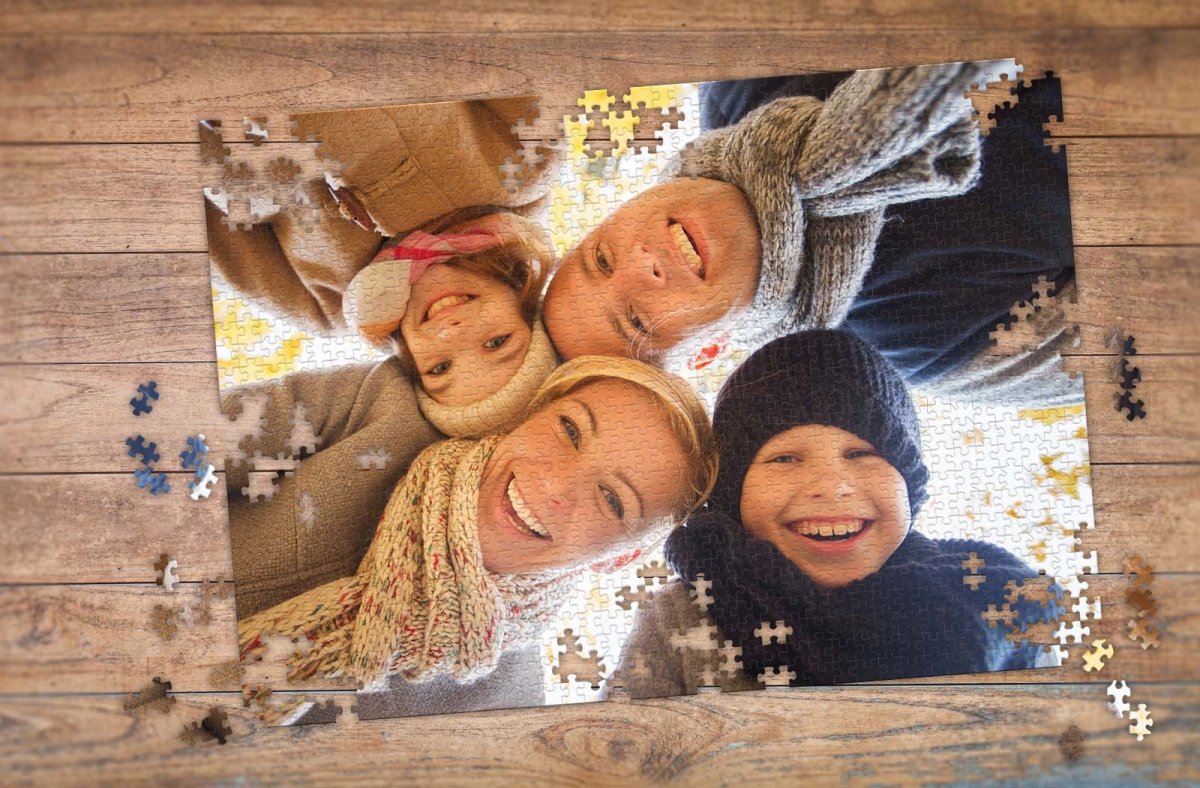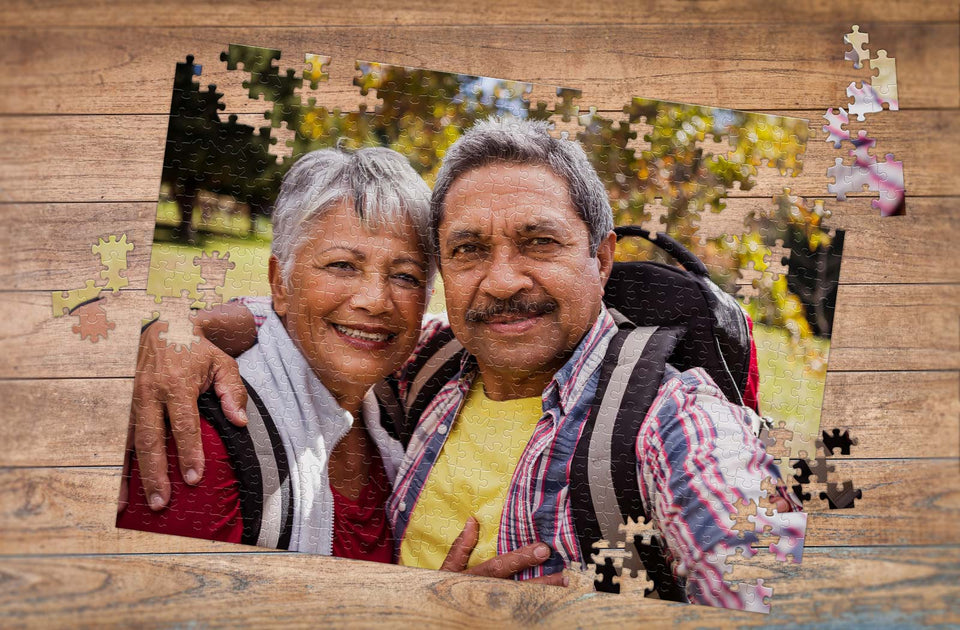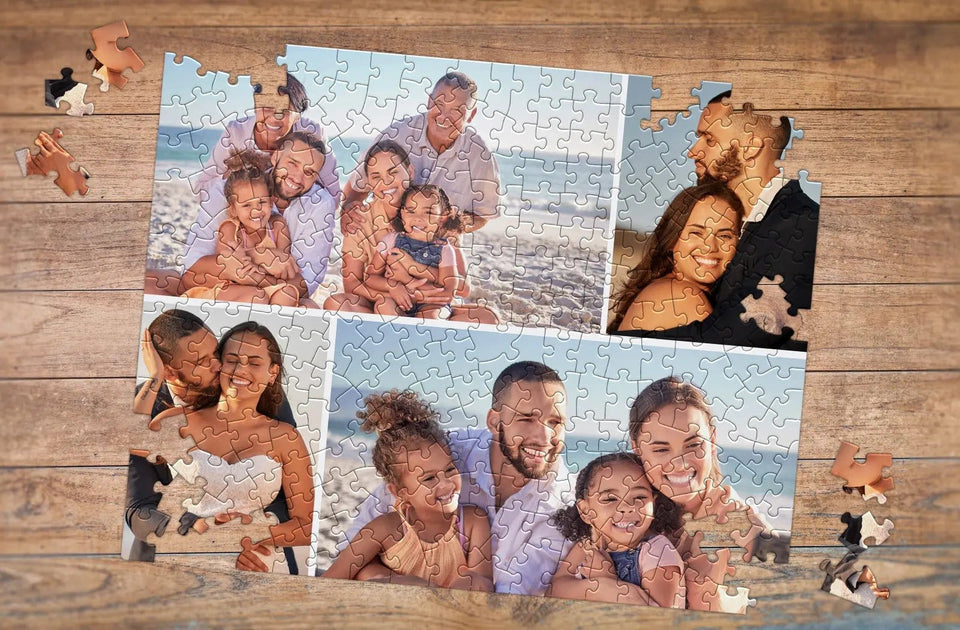Choosing the right jigsaw puzzle size isn't just about finding a puzzle that fits your table. It's also about meeting your skill level and satisfying your tastes. Whether you're trying to design a custom jigsaw puzzle for you and your partner or choose a picture puzzle for your kids, understanding various jigsaw puzzle dimensions can help you plan your solo puzzle evening or fun family activity.
Let's review our puzzle size chart to understand better different puzzle piece counts so you can discover your perfect puzzle size and pieces.
Puzzle Size Chart of Common Dimensions
Regarding jigsaw puzzles, size matters; puzzle dimensions affect the space required and the challenge level. Here's a quick guide to standard sizes by piece count:
|
Number of Pieces |
Dimensions (in inches) |
Best for |
|
1,000 pieces |
19.25 x 26.625, or 20 x 30 |
Adults and children 10+ who enjoy detailed, immersive puzzle experiences (10+ hours required) |
|
500 pieces |
16 x 20, or 18 x 24 |
Children 10+, adults, and intermediate puzzlers or those with limited space |
|
260 pieces |
16 x 20 |
Children 8-9 years, adults, and seniors looking for a moderate challenge |
|
100 pieces |
10 x 14 |
Children 5-8 years, seniors, or puzzle newbies who want a quick yet rewarding activity |
|
48 pieces |
10 x 14 |
Children 4-6 years, seniors, or those wanting a fun introduction to jigsaw puzzles |
Shop our holiday jigsaw puzzle deals!
What Is the Right Puzzle Size for You?
Puzzles can range from a few pieces to a few thousand pieces, offering varying difficulty levels and time commitment. Knowing a puzzle's dimensions and challenge level will help you determine whether it's the ideal one, whether you're selecting a puzzle for yourself or as a gift. Let's review some of the most common jigsaw puzzle sizes.
50-Piece Puzzles
A 50-piece puzzle is perfect for young kids starting out with jigsaw puzzles. With large, easy-to-handle pieces, it's ideal for ages 4 to 6 or seniors looking for a light challenge. Completing the puzzle offers a fun, rewarding experience, making it a great custom birthday gift or a fun activity for playdates and family time.
How Big Is a 50-Piece Puzzle?
A 50-piece puzzle typically measures around 10 by 14 inches, making it great for young puzzlers or those with limited space. The dimensions may vary slightly depending on the brand, but they’re generally designed to be small enough for children to handle comfortably.
How Long Does It Take to Solve a 50-Piece Puzzle?
The time to solve a 50-piece puzzle depends on the age and experience of the solver. Young children may take between 30 minutes and 1 hour to complete the puzzle, while adults or older kids with more experience may solve it in less time.
100-Piece Puzzles
A 100-piece puzzle is perfect for young children just getting into the habit of solving puzzles. These typically contain XXL-sized pieces measuring 1 ½" to 2 ½" each, making 100-piece puzzles ideal for kids ages 5 to 8 or older kids looking for a more manageable challenge. Young puzzlers, in particular, will revel in seeing the final image come together, making a 100-piece puzzle a perfect gift on a special occasion or a great activity for a birthday party or playdate.
How Big Is a 100-Piece Puzzle?
A 100-piece puzzle is typically 16 by 20 inches, although the exact dimensions will vary by brand. It’s a good idea to determine the dimensions of a 100-piece puzzle before making your purchase.
How Long Does It Take to Solve a 100-Piece Puzzle?
In general, it will take 1-2 hours to solve a 100-piece puzzle, although the size of the puzzle and the number of people working on it will determine how long it ultimately takes. For example, if the puzzle is a giant puzzle, or there are more than a few people working together, the puzzle will require a smaller time commitment.
Also, consider the age of the person working on the puzzle. A puzzle pro can complete puzzles quickly, while a young child will require more time. Landscapes or puzzles with only one or two colors may be more difficult and take longer, whereas a puzzle with a distinct image or pattern may be easier.
260-Piece Puzzles
If you're looking to assemble a puzzle that requires more time, a 260-piece puzzle may be what you need. This puzzle size suits all skill levels, offering a satisfying challenge and a quick, enjoyable win without compromising on fun or difficulty.
How Big Is a 260-Piece Puzzle?
A 260-piece puzzle is usually around 16 by 20 inches, but the puzzle pieces may be significantly smaller than those for a 100-piece puzzle. While the exact size can vary, it’s a great in-between size for both kids and adults who want a puzzle that's fun without being overwhelming.
How Long Does It Take to Solve a 260-Piece Puzzle?
On average, a 260-piece puzzle takes about 2 to 4 hours to complete. It really depends on the difficulty of the image and who's working on it, though. Kids around 8 to 9 years old or adults can expect a satisfying challenge without spending the whole day on it.
500-Piece Puzzles
If you prefer something with a higher degree of difficulty or you want to take your time with a more complicated puzzle, try a 500-piece puzzle. On average, a puzzle of this size takes between two and five hours, balancing complexity with manageability to make for an enjoyable experience for everyone.
How Big Is a 500-Piece Puzzle?
A 500-piece puzzle typically measures about 16 by 20 inches or 18 by 24 inches, depending on the brand. It's a comfortable size for intermediate puzzlers, offering a challenge without taking up too much space.
How Long Does It Take to Solve a 500-Piece Puzzle?
A 500-piece puzzle usually takes around 4 to 8 hours to complete, though this can vary based on the complexity of the image and the puzzler's experience. It’s a great option for those who want a moderately challenging puzzle that can be done in a few sessions.
1,000-Piece Puzzle
For avid puzzlers, a 1,000-piece puzzle offers a tough challenge and a fantastic sense of achievement. This type of puzzle typically has large dimensions — for example, more than 24 inches wide — and can take 10 to 16 hours to complete.
Because of the necessary time commitment and challenge, a 1,000-piece puzzle is not usually the best choice for small children or anyone who might find handling small pieces difficult. Those individuals might instead get more satisfaction out of a puzzle with fewer and larger pieces. In general, a 1,000 piece puzzle is best for ages 12 and up.
How Big Is a 1,000-Piece Puzzle?
A 1,000-piece puzzle is typically around 19 by 27 inches or slightly larger, depending on the brand. This size makes it perfect for adults who love a detailed, immersive puzzle experience.
How Long Does It Take to Solve a 1,000-Piece Puzzle?
On average, a 1,000-piece puzzle takes about 10 to 16 hours to complete. The time can vary based on the complexity of the image and the skill level of the puzzler. Some might finish faster, while intricate designs or puzzles with fewer distinct colors can take longer to solve.
How to Select the Best Puzzle Size and Piece Count
Choosing the right puzzle involves more than just picking a picture; it's about balancing size, piece count, and skill level. Here's how to find the best fit:
Selecting by Puzzle Size and Overall Difficulty
Larger puzzles occupy more space and offer a more immersive challenge, ideal for dedicated areas and longer puzzle sessions. Also, more pieces generally mean greater complexity. The shape and variety of the pieces can also contribute to the puzzle’s difficulty. For example, many people find ribbon-cut puzzles to be easier than random-cut puzzles since the uniform shape of ribbon-cut pieces makes their placement more predictable.
Workspace Size
Larger puzzles, such as 1,000-piece sets, often require more than just a table corner to spread out. Before you start assembling, ensure that your surface is large enough to accommodate the puzzle's dimensions. For reference, a completed 1,000-piece puzzle may be over 24 inches wide, meaning you'll need a workspace that provides room for the puzzle and sorting and organizing pieces. Puzzle mats or foldable tables are great options for easy setup and portability.
Puzzle Storage Solutions
Suppose you don't have the luxury of leaving a puzzle out for extended periods or like to work on puzzles intermittently. In that case, there are several storage solutions to consider. Puzzle mats, for example, allow you to roll up and store your puzzle in progress without disturbing your work. This is especially helpful for larger puzzles that may take days or weeks to complete. Similarly, puzzle boards with built-in storage trays can make organizing and storing loose pieces easier while keeping your work surface clear.
Selecting Puzzles by Time Commitment
When deciding on the right puzzle size, consider how much time you want to spend completing it. A 1,000-piece puzzle might take more than 10 hours to finish, whereas smaller puzzles, such as a 100-piece or 260-piece puzzle, could require between 30 minutes and a few hours of effort.
Selecting Puzzles by Experience
Your puzzle experience can also be a factor when choosing the correct puzzle.
- Beginners: Start with smaller puzzles and fewer pieces for quick, satisfying accomplishments.
- Intermediate: Opt for medium-sized puzzles with a higher piece count to challenge your growing puzzle skills.
- Experts: You may prefer larger puzzles with high piece counts for a complex yet rewarding experience.
Selecting Puzzles by Occasion
Think about who will be using the puzzle and what their preferences might be.
- For yourself: Pick a puzzle that matches your interests, preferred difficulty, and experience level.
- For family or friends: Choose puzzles that suit the person's age and skill level. If you're selecting a puzzle for a group of multiple individuals, try to choose one that everyone can enjoy and benefit from.
- As a gift: Consider whether a theme might be appropriate besides the recipient's experience level and preferences. Is it a holiday or a person's birthday? For example, you might choose a wedding anniversary puzzle for your spouse, selecting a size you can complete in a single evening.
Selecting Puzzles by Age
Choosing the right puzzle size and piece count for each age group can turn a simple pastime into a rewarding and brain-boosting activity. With the right fit, anyone can enjoy the puzzling journey!
Puzzles for Kids
Introduce children to puzzles with 48 puzzle pieces or 50-piece sets to foster early development of problem-solving skills, spatial awareness, and fine motor skills. These puzzles are manageable for younger children and help build their confidence. As they grow, 100-piece puzzles introduce more complexity, requiring them to think critically and pay closer attention to details.
For older kids, 200 to 300-piece puzzles provide a more challenging experience, encouraging perseverance, patience, and advanced reasoning skills. The colorful and engaging images in children's puzzles help keep them motivated and excited about completing each project.
Puzzles for Adults
For adults, a 500-piece puzzle strikes the right balance between relaxation and challenge, offering a satisfying experience without being overwhelming. Those looking for a deeper mental workout or a longer time commitment can opt for 1,000-piece puzzles, which provide a more immersive experience. With puzzles featuring a variety of themes, from nature to abstract art, adults can enjoy stimulating their minds while unwinding from daily stress.
Puzzles for Seniors
Seniors can benefit from puzzles with 100 pieces or 1,000 pieces, depending on their comfort level and dexterity. Puzzles with larger pieces are ideal for those with vision or fine motor challenges while providing an engaging and enjoyable mental workout. Clear, vivid imagery and familiar themes can also enhance the experience by promoting healthy cognitive function and providing a sense of accomplishment.
What Puzzle Size is Ideal for Quality Prints?
Choosing the right puzzle size can greatly enhance the quality of your prints. With various jigsaw puzzle sizes available, you can customize your puzzle based on the number of pieces and the complexity you prefer. Larger puzzles, such as a 1000-piece photo puzzle, are ideal for intricate designs and detailed images. It's important to balance the level of challenge with the final display quality for the best results.
Stock Jigsaw Puzzles vs. Custom Photo Puzzles
When choosing a puzzle, you face the dilemma of designing stock image puzzles or custom photo puzzles. Each has its charms and advantages. Let's break it down:
Stock Puzzles
Stock puzzles are pre-designed and come in a variety of themes and images. They're readily available and offer various artistic choices, from landscapes and cityscapes to abstract art. These puzzles are great for those who love surprises and discovering new designs.
Custom Photo Puzzles
Custom photo puzzles — for example, collage photo puzzles — offer a unique way to personalize cherished memories. By turning a collection of favorite photos into a single puzzle, you create a meaningful experience that allows you to relive special moments. They also make thoughtful, creative gifts for celebrating important occasions.
Why Make a Custom Puzzle?
These days, retailers make creating a custom puzzle easy. All you need is the right photo and a few seconds. The process can be a lot of fun!
Custom puzzles offer a deeper emotional connection to the puzzler. Imagine piecing together a family photo, a snapshot from a memorable vacation, or an image of a beloved pet. The satisfaction of completing a puzzle is amplified when it's a picture that holds special significance to you.
Benefits of Solving Puzzles
Puzzles can be a great way to pass the time but also have cognitive and emotional benefits.
Researchers have linked solving puzzles to increasing cognitive abilities. Regularly engaging in puzzles can improve problem-solving skills by encouraging creative thinking and strategic analysis. They also enhance memory and concentration, which may help reduce the risk of cognitive decline.
Puzzles promote focus and patience, offering a relaxing break from stress. Completing a puzzle boosts dopamine levels, improving mood, motivation, and overall brain function. Additionally, puzzles can foster teamwork and social interaction, strengthening relationships through collaboration.
Frequently Asked Questions
What size puzzle should I start with?
Start with a 48-piece, 50-piece, or 100-piece puzzle if you're a beginner, then move to 200 to 300 pieces for a medium challenge. Experienced puzzlers can enjoy 500-piece puzzles for a more engaging experience. Choose based on your comfort and gradually increase difficulty as your skills improve.
What is the best puzzle size for adults?
Adults typically enjoy puzzles between 500 and 1,000 pieces. A 500-piece puzzle offers a moderate challenge, while a 1000-piece puzzle is more intricate and time-consuming.
Should I get a 500 or 1,000-piece puzzle?
A 500-piece puzzle is great for a moderate challenge, while a 1,000-piece puzzle provides a more detailed and immersive experience. Choose based on the level of difficulty you prefer.
Is a 500-piece puzzle too easy for adults?
A 500-piece puzzle is ideal for beginners or casual puzzlers. However, it might be too easy for experienced puzzlers who prefer more complex challenges.
What size would a 1,000-piece puzzle be?
A standard 1,000-piece puzzle is typically around 19 x 27 inches, offering a substantial but manageable canvas for most puzzle boards or tables.
How big is a 100-piece puzzle?
The typical dimensions of a 100-piece puzzle are around 16 x 20 inches, although this can vary depending on the brand. Knowing how big a 100-piece puzzle is beneficial when purchasing.
How long should a 100-piece puzzle take?
A 100-piece puzzle typically takes between 1 to 2 hours to complete, depending on the puzzle's complexity and the solver's skill and experience.
How do I choose a puzzle frame size?
Choose a puzzle frame size based on the dimensions of the completed puzzle, typically adding a few inches for matting or borders.
What is a good size for a puzzle board?
A good puzzle board should be at least 2 to 4 inches larger than the puzzle's dimensions to provide space for sorting pieces and assembling the puzzle.
Is a 500-piece puzzle too easy for adults?
A 500-piece puzzle can be moderately challenging for adults and is a good option for casual puzzle solvers or those looking for a quick yet engaging activity.








